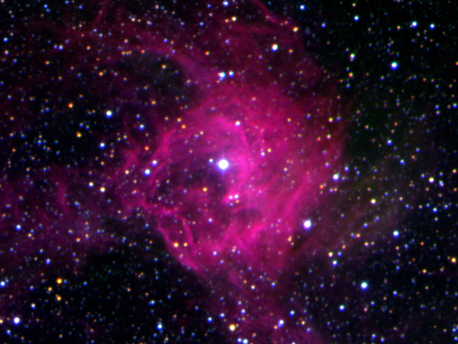What are you made of?
Are we made of 'stardust'?
 © ESO
|
Heavy elements are created during a supernova explosion, enriching interstellar space.
Around one second after the Big Bang, the cosmos was already filled with protons, neutrons and electrons. They were in a sea of 'photons', or radiation particles. This high-energy radiation initially prevented the formation of hydrogen atoms from protons and electrons and heavier nuclei from multiple protons and neutrons. It was only in the following minutes that the nuclei of the two lighter elements helium (two protons) and lithium (three protons) were formed.
Stars as the birthplace of chemical elements
Even today, the majority of matter in the cosmos exists in the form of hydrogen and helium. However, without the variety of atom types that is shown in the periodic table of the elements, the existence of planets and human life would not be possible. Surprisingly, most of the elements were formed inside stars. In their interiors, hydrogen fuses to form helium and, in higher-mass stars, nuclear fusions of this type also lead to the creation of carbon, oxygen and heavier elements, including iron. Elements that are heavier than iron are formed when additional neutrons and protons become attached. For this to happen, physical conditions such as those that occur only during supernova explosions and inside red giant stars are necessary (see How long will the Sun continue to shine?).
Afterward, supernovae and stellar winds distribute the newly formed elements into space in the form of 'stardust'. If new star systems are later created from this dust, planets can also be formed from the heavier elements that are now present. This is when life originated – at least on planet Earth.
German Aerospace Center
What are you made of?
Are we made of 'stardust'?
 © ESO
|
Heavy elements are created during a supernova explosion, enriching interstellar space.
Around one second after the Big Bang, the cosmos was already filled with protons, neutrons and electrons. They were in a sea of 'photons', or radiation particles. This high-energy radiation initially prevented the formation of hydrogen atoms from protons and electrons and heavier nuclei from multiple protons and neutrons. It was only in the following minutes that the nuclei of the two lighter elements helium (two protons) and lithium (three protons) were formed.
Stars as the birthplace of chemical elements
Even today, the majority of matter in the cosmos exists in the form of hydrogen and helium. However, without the variety of atom types that is shown in the periodic table of the elements, the existence of planets and human life would not be possible. Surprisingly, most of the elements were formed inside stars. In their interiors, hydrogen fuses to form helium and, in higher-mass stars, nuclear fusions of this type also lead to the creation of carbon, oxygen and heavier elements, including iron. Elements that are heavier than iron are formed when additional neutrons and protons become attached. For this to happen, physical conditions such as those that occur only during supernova explosions and inside red giant stars are necessary (see How long will the Sun continue to shine?).
Afterward, supernovae and stellar winds distribute the newly formed elements into space in the form of 'stardust'. If new star systems are later created from this dust, planets can also be formed from the heavier elements that are now present. This is when life originated – at least on planet Earth.
German Aerospace Center






